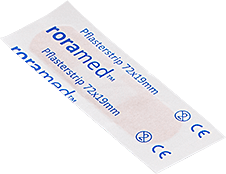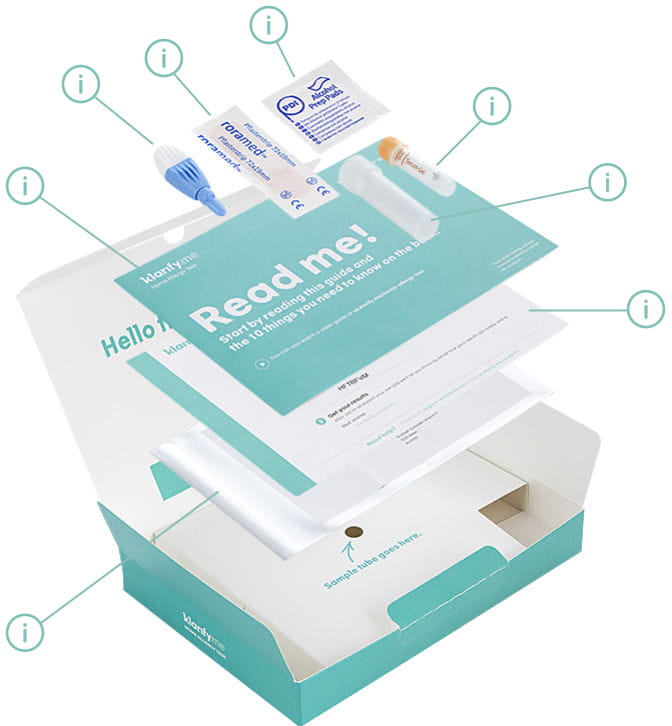Dog allergy testing
Just so we’re clear from the start, this article is all about what you can do if you think you might be experiencing allergy symptoms to dogs. We’re talking the annoying sneezes, runny nose, sniffles and itchy, watery eyes when you’re around a dog.
Do you wonder if you might be allergic to dog hair? Are you interested in learning more about allergy testing? And specifically, dog allergy testing? Read on.
Allergies to dogs and other pets with hair and fur are very common. But it’s not a dog’s hair or fur itself that causes an allergic reaction. Dog allergy is caused by the protein in the dog’s saliva, urine and dander. Pet dander from a dog is flakes of their shed skin. It can spread when the dog moults and grooms itself. But how do you know if the symptoms you experience when you're with a dog are signs of allergy because of the dog or something else? Well, you could make a start with a dog allergy test.
About the dog allergy test
The antibody Immunoglobulin E (IgE) plays a key role in allergies. IgE is an antibody produced by our immune system in response to an otherwise harmful substance that is perceived as a threat. By testing for and identifying specific IgE antibodies in your blood, the Home Allergy Test can give an indication of your sensitisation to potential triggers.
Dog allergy testing is a first step to finding out if dog allergy might be causing your symptoms. The Home Allergy Test is easy to use and it's backed by science. It offers comprehensive dog allergy testing. Using sophisticated technology, it analyses your blood for sensitisation to 25 different pet dander allergens and components including cat, dog and horse allergens. It also tests for hundreds of other substances.
The dog allergy testing kit contains everything you need to collect a small blood sample. Allow about 30 minutes to collect your blood sample. We’ve got a step-by-step video guide to help you collect a small blood sample for dog allergy testing. You need to post your blood sample to our partner lab for testing and analysis. There's a prepaid return envelope included in the box. You need to post the blood sample within 24 hours after collecting it to make sure it’s stable and suitable for dog allergy testing.
Your dog allergy test results will be available within two weeks. You'll be able to access your dog allergy test results via your online account. The dog allergy test results show the level of specific IgE antibodies in your blood. Your test results can indicate if you’re sensitised to any of the hundreds of different allergens tested, including allergens from dogs. Order your dog allergy test today.
Many allergens, one test
The Home Allergy Test tests and analyses your body’s reaction to 294 different allergens including:- Pollen 59
- Pets 25
- Insect stings 10
- Moulds & yeasts 13
- Foods 154
- Other 14
Symptoms of dog allergy
One of the symptoms of dog allergy is allergic rhinitis. Allergic rhinitis is an inflammatory condition affecting the lining on the inside of your nose. When the allergens from the dog come into contact with your mouth, eyes or nose your body mistakenly interprets them as threatening intruders. It sets off a chain of allergic reactions in defence. Cells in your body release histamine, which makes the lining of your nose swell. And extra mucus is produced to try to clear away the threat.
Dog allergy symptoms checklist:- Stuffy, runny nose
- Sneezing
- Itchy nose
- Itchy, red or watery eyes
- Coughing
- Breathing difficulties
- Tight chest or wheezing/li>
- Eczema/skin rash/hives /li>
- Anaphylaxis
Dog allergy can involve one or more of the symptoms from the checklist. Symptoms of allergy can vary from person to person. You may experience mild, moderate or severe symptoms depending upon your sensitivity and level of exposure.
All you need is in the box
Prepaid return envelope
Use this to send your sample to the lab
Welcome card
Includes your unique activation code and instructions how to use it
Step-by-step guide
Start by reading this guide and the 10 things you need to know on the back
Lancing device
Sterile device to prick your fingertip to obtain a small blood sample
Plaster
To put on your fingertip after collecting the blood sample
Alcohol wipes
Use to sanitise your finger
Transport tube
Filled sample tube goes into the transport tube. Both tubes are then sealed into the prepaid return envelope for posting to the lab
Sample tube
Tube to collect about 6 drops of blood










Why you should consider dog allergy testing
Being allergic to dogs is usually like any other respiratory allergy. And respiratory allergies can be more than just a nuisance. If you have an allergy to dogs the symptoms can have quite an impact on your everyday life. You might feel it affects your choice of social activities with friends and family. Especially if they have dogs!
But how do you know how to best manage your symptoms if you aren’t sure what’s causing them? Perhaps it's time to think about getting a dog allergy test.
Allergy testing gives you the opportunity to find out which allergens trigger your symptoms and rule others out. The Home Allergy Test detects Immunoglobulin E (IgE) in your blood. IgE is an antibody produced by the immune system to protect us from outside intruders such as parasites. IgE plays a vital role in allergic reactions to many substances.
Allergy testing for specific IgE antibodies in your blood can give an indication of your sensitisation to specific allergens. It doesn’t mean you definitely have allergies. Testing for sensitisation can be a first step to finding out if you have allergies. Your doctor will consider your medical history alongside any test results in order to make a diagnosis of allergies. Being diagnosed with allergy means you're both sensitised and experience an allergic reaction.
Armed with comprehensive information from reliable allergy testing, managing your symptoms can become easier. For example, if your dog allergy test results indicate you're sensitised to allergens from dogs, you can try to minimise your contact with dogs. And with an accurate diagnosis, you'll be able to discuss dog allergy treatment options with your doctor and get access to the most suitable treatment for you.
Dog allergy: a closer look
If you’re allergic to dogs, it doesn’t mean you’re allergic to the dog itself. It means you experience an allergic reaction when you come into contact with the protein in a dog’s saliva, urine or particles of their shed skin, dog dander.
The best way to control allergic reactions to dogs is to avoid any contact with them. Being allergic to dogs isn’t easy. Many people have dogs as pets so they can be difficult to avoid. If you love your pet and avoiding your dog just isn't an option, we do understand. We love dogs too! Unfortunately, there's no such thing as a truly non-allergic dog, sometimes referred to as a hypo-allergenic dog. Any dog can potentially cause an allergic reaction.
An allergic reaction starts with your immune system. Our immune system protects us from infectious bacteria, viruses, fungi and parasites. But if you have an allergy to dogs, their saliva, urine or dander is perceived as a threat and your body takes defensive action to try and get rid of that threat as quickly as it can.
You probably won't have an allergic reaction to a dog the first time you come into contact with one. There's a process to developing allergies. The process is called sensitisation.
The process begins with your body mistakenly believing that this usually harmless substance is actually harmful. It records the structure of the allergen so it can produce specific IgE antibodies to fight it.
When specific IgE antibodies are present in your blood it’s called being sensitised. Once you've been sensitised to an allergen, your body will produce IgE every time you come into contact with that particular allergen again.
The next time you encounter that allergen, the customised IgE antibodies recognise it. And prompt other cells to start the allergic reaction. Your body releases various chemicals, including histamine as part of your body’s defence system. Histamine is part of an inflammatory response. Your body wants to get rid of the intruder, and fast!
White blood cells and various fluids flow to the site of the attack to help. This causes amongst other things inflammation and swelling in, for example, your eyes, your skin, your nose and throat. This can make you sneeze, make your eyes watery and your nose runny, your skin itchy… whatever it takes to get the job done.
Being sensitised isn't the same as being allergic. Sensitisation is the first step in developing allergies. You can be sensitised without being allergic, but you can’t be allergic without being sensitised first. Testing for and detecting sensitisation can be a useful tool to identify potential triggers. When you’re diagnosed with dog allergy it means that you're both sensitised and experience an allergic reaction to allergens produced by dogs.
Others say
"Very clear instructions and the packaging is high quality. Looking forward to receiving the results." - Sara P
"I got the results and I have to say, I am very impressed.
I have only ever noticed suffering from sensitivity to cats, dust and a bit on grass before moving house at the end of Feb and I’ve always been able to control these reactions with off the shelf antihistamine, the test confirmed sensitivity to all of these.
Since moving I have suffered badly from a far more severe reaction to something unknown, I had assumed it was pollen from the symptoms as I am now surrounded by trees and flowering plants and there is a park behind the house, so plenty of grass too. My hope when taking the test was to find out if this new issue was a general sensitivity or if there was something specific in my new environment which was causing it. I am delighted that the test came back with such a strong positive on Ash tree pollen along with a moderate on Olive (which as I’m reading are in some way connected) while showing no sensitivity to other tree pollen types at all.
Having checked the pollen season for Ash trees it seems to coincide really well with when I had my symptoms, I.e. through March and April I was really bad but its clearing up now in May to the point that its negligible now. Looking around outside I think I’ve spotted the culprit at the back of my garden right next to where I’ve been sitting when outside!
I was sceptical about spending the money on this but at the time my symptoms were so harsh I think I’d have tried almost anything! I’m so glad that I did this now." - Rob S.
"Great product! For a while now, I have suspected that my son might have an allergy. I was leaning towards tree or grass pollen, but he didn’t really seem to be consistently bothered when being outside. I bought the home allergy test to understand what he was sensitised to. The guide that comes with the product, made it a simple exercise to complete the test. Drawing the blood took about 20 seconds, and there is really little hassle at all.
The report came back within a couple of weeks and showed high sensitisation to house dust mite. Didn’t think of that beforehand. So now we know where to focus and we have had dialogue with our doctor for next steps and proper treatment." - Morten S.

